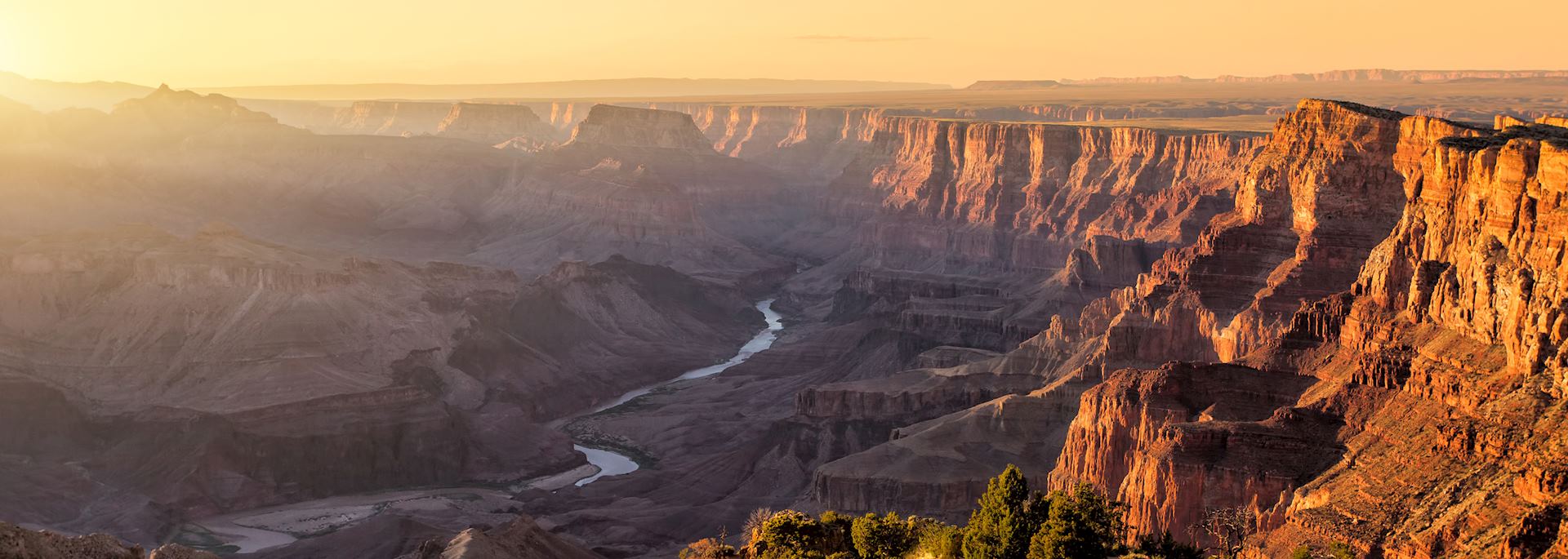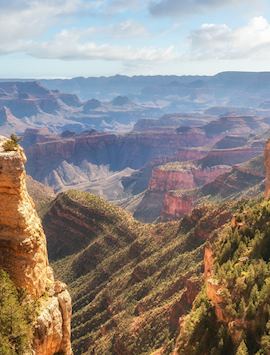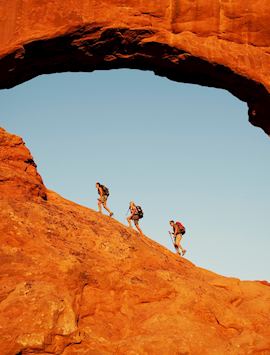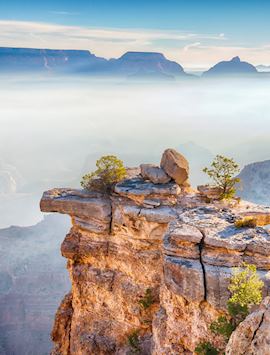By USA specialist Ross
As you step onto the rim of the Grand Canyon, the great, yawning chasm in the earth commands your attention. You feel dwarfed as you realize that dot across the canyon is a tree, those lines in the rock signify the passing of millennia, and everything in front of you has been carved out by the Colorado River far below.
Being one of the best-known landmarks in the world means the canyon inevitably gets crowded. But, with a bit of careful planning, you can arrange a quieter experience. I’ve tackled some of the questions I’m most commonly asked about visiting the Grand Canyon, from where to visit to the best hikes — and how to beat the crowds.
Should I visit the North Rim or the South Rim?
Separated by just 16 km (10 miles) geographically, the North and South Rims are nevertheless 346 km (215 miles) apart by road.
While the views don’t differ hugely, the easier-access South Rim is far busier than the North Rim, which is arguably more atmospheric.
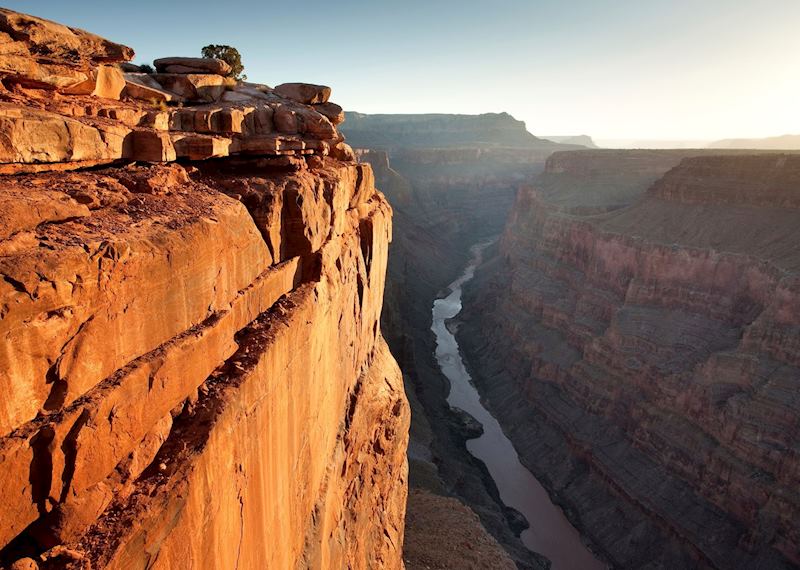
If it’s your first visit to the canyon, I recommend seeing it from the South Rim. There’s more to do here, it’s easier to get to, and there are more places to stay. It’s true that you’ll be sharing the experience with many other visitors, but we can steer you away from the busiest areas.
The North Rim requires a drive of at least three and a half hours to get to (more on this later), so we always recommend staying for two nights. Accommodation is very limited, so plan well in advance.
But, once there, you’re rewarded with uninterrupted views over the canyon, with barely anyone else in sight. This area is largely undeveloped, so you get more sense of what the canyon would have been like before it was discovered. Standing close to the edge, you can take in the canyon’s gaping silence, pierced only by a bird call or vegetation rustling in the wind.
How do I get to the Grand Canyon?
If you’re driving to the South Rim from Las Vegas, it takes about four and a half hours. Alternatively, you can fly into Phoenix and drive four hours north to the rim. Once you get to the town of Williams, it’s roughly an hour’s drive north along Highway 64. Or, you can take the historic train that runs along the Grand Canyon Railway, which has transported visitors from Williams to the canyon since 1901.
If you’re visiting the North Rim, your only option is to get there by car. It’s about a six-hour drive from Phoenix, four and a half hours from Las Vegas or six and a half hours from Salt Lake City. You can also drive between the two rims, which takes about four and a half hours.
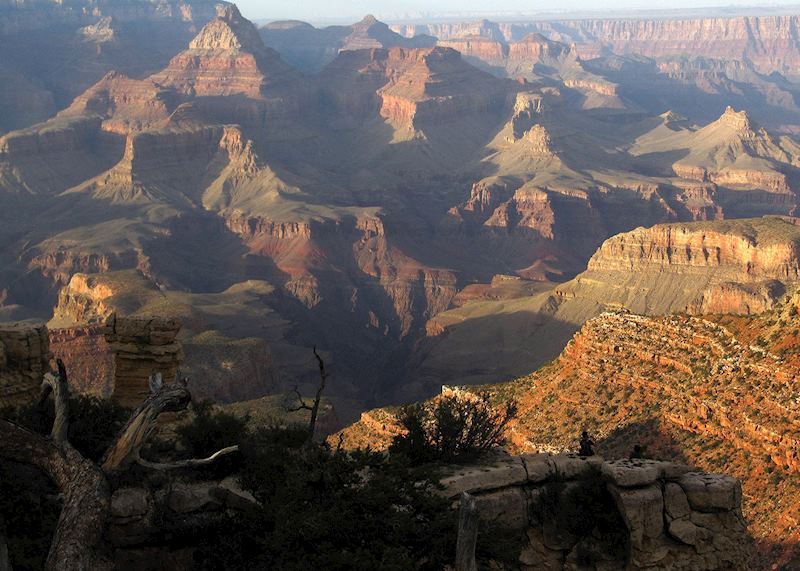
And, I recommend picking up a national park pass before you enter the main gate to avoid the lines. You can purchase one at the National Geographic Visitor Center in the town of Tusayan, just outside the park, or at another national park if the Grand Canyon isn’t your first stop.
It also pays dividends to explore with a guide or ranger, who can take you to quieter spots and will know the best times to visit certain areas.
We can arrange for you to travel around the rim in an open-air 4x4 with a private guide, stopping off at points of interest. The guides are good fun and extremely knowledgeable about the canyon’s geology, history and wildlife. The vehicles are also very comfortable, with space for up to nine passengers.
How do you access the South Rim, and what are the best ways to get around?
If you’re driving to the South Rim from Las Vegas, it takes about four and a half hours. Alternatively, you can fly into Phoenix and drive four hours north to the rim. Once you get to the town of Williams, it’s roughly an hour’s drive north along Highway 64. Or, you can take the historic train that runs along the Grand Canyon Railway, which has transported visitors from Williams to the canyon since 1901.
Once at the rim, you could opt to take the free hop-on, hop-off shuttle bus, which drops you off at key locations. You might need to line up at some of the busier pick-up points.
It’s also easy to walk along the rim — the terrain is flat and it’s up to you how far you want to go.
Or, you could drive the 40-km (25-mile) Desert View Drive, which runs eastwards along the rim. There are plenty of viewpoints along the way, including some where you can see the Colorado River snaking below.
Can I see the Grand Canyon by helicopter?

You can take a helicopter ride from Las Vegas to the Grand Canyon, which is a good option if you’re short on time. Trips vary in length, but generally involve flying over desert landscapes, the Hoover Dam and Lake Mead.
Along the way, audio narration points out key landmarks you can see from the air. Then, the canyon cracks open the landscape and your helicopter lands partway down for you to get out and take photographs.
You can also take a 30-minute helicopter ride from the South Rim for an eagle’s-eye view over the canyon.
You take off from Tusayan, passing over the Kaibab National Forest before flying over the canyon itself — look down and you’ll get a sense of how deep the canyon is as the Colorado River glistens below.
Your pilot will fly you to the Dragon Corridor, the widest and deepest section of the canyon, and you’ll pass over the more densely forested North Rim.
What are the best Grand Canyon hiking trails?
The simple-but-effective Rim Trail begins at the Grand Canyon Visitor Center and stretches 21 km (13 miles) west to Hermits Rest. It’s a flat, mostly paved path, taking you along the rim and giving you far-reaching views over the canyon. You can choose to walk part of the route and catch a shuttle bus back from various points.
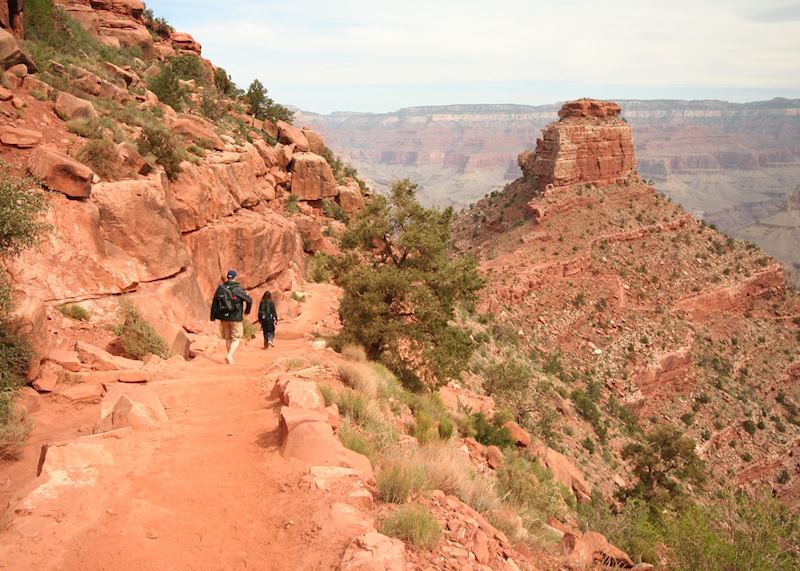
For something a little more strenuous, follow the South Kaibab Trail down into the canyon. A shuttle bus takes you to the trailhead on the South Rim. Then, you can choose to walk down to Cedar Ridge, a 4.8-km (3-mile) round trip, or continue to Skeleton Point, which is twice as far but gives you views of the Colorado River below. If it’s a hot day, I recommend doing the shorter stretch because you’ll have a steep ascent back to the rim.
You can hike these trails independently, or we can arrange for a private guide to join you. Your guide will point out key landmarks and can tell you more about the canyon’s geology, wildlife and history. Free ranger walks are also available in larger groups, if you just want a general introduction to the canyon.
If you’re at the North Rim, I suggest the Bright Angel Point Trail. While only 1.2 km (0.7 miles) in length and entirely paved, it does get steep in places. You set off from behind Grand Canyon Lodge and follow the pathway along the Bright Angel Peninsula to a viewpoint that looks across the east and west of the canyon. Standing here, you can see peaks such as the striped, vegetation-smeared Oza Butte and the knobbly Manu Temple.
Can you walk down to the bottom of the canyon?
We’d advise not to — it would take far too long to reach the bottom and then return to the top, and it would be a very strenuous ascent. It’s best to hike part of the way down, avoiding the hottest parts of the day.
Watching the sunrise. Not as many people make the effort to watch the sunrise compared with sunset, so you can really take everything in.
I woke up to clear skies, and made my way to Mather Point on the South Rim. While this is one of the most popular places to see the sunrise, you can walk a bit farther along to find a space of your own.
When I got there, the canyon was cloaked in a charcoal-gray darkness. But, as I watched, the sun crept up onto the horizon and pale light gradually slipped over the canyon. It was like a curtain had been opened, revealing the textures and rust-red strata of the rock in a warm glow.
Where should I stay when I visit the Grand Canyon?
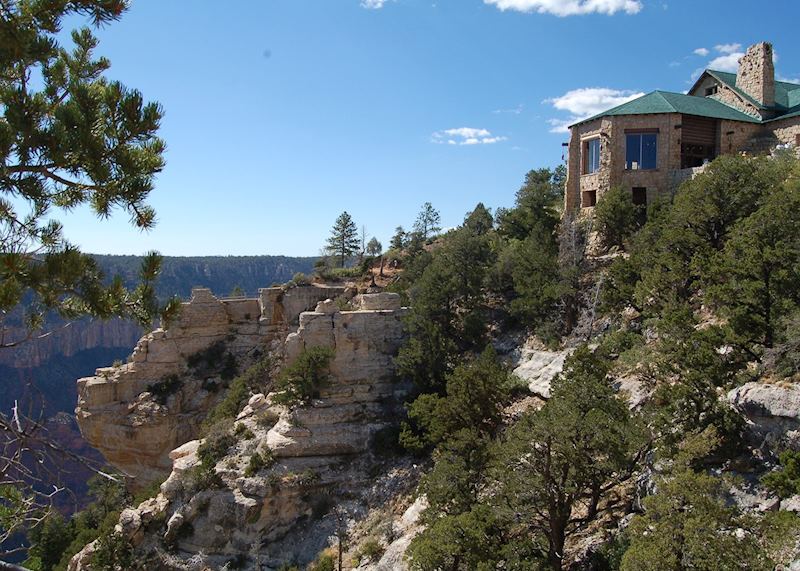
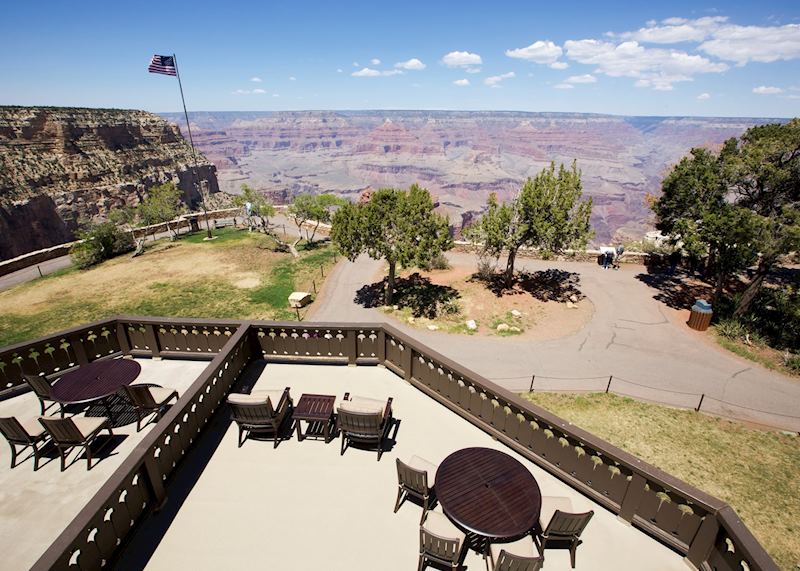
For the North Rim, your only option is Grand Canyon Lodge. Simple in facilities and style, it offers a mixture of cabin- and motel-style rooms, and has been accommodating visitors since 1928.
There’s more choice at the South Rim, although hotels still fill up quickly. If you want to stay within the national park, Yavapai Lodge East is a good simple option just a ten-minute walk or short shuttle ride to the canyon.
There’s also the El Tovar Hotel, just steps from the rim. While rooms here are still fairly simple, the hotel has built a good reputation since it opened in 1905 and hosted presidents and royalty over the years.
Alternatively, stay a ten-minute drive outside the park in Tusayan, where there are more restaurants and amenities. The Best Western Premier Squire Inn has a wide range of facilities, including indoor and outdoor pools and a bowling alley.
How many days do you need at the Grand Canyon?
I’d say two days is best, so you can enjoy at least one full day exploring the canyon in whichever way you choose without needing to rush.
It’s easy to tag a visit on to a wider trip — you can combine a visit to the South Rim or North Rim with a trip exploring other canyons and rock formations in the western USA, including Zion National Park and Monument Valley. Or, visit the South Rim before or after a California self-drive trip, following our Best of the West itinerary.
What’s the best time of year to visit the Grand Canyon?
You can visit the Grand Canyon at any time of year, but for warm temperatures without the crowds, I recommend visiting between April and May or September and October. The summer months between June and August can get very hot. There are also more visitors during this period as people go on their summer travels. The North Rim closes during winter when snow makes it inaccessible. The South Rim is open all year but can be difficult to get to in winter if there’s been snowfall.
What has been your highlight of visiting the Grand Canyon?
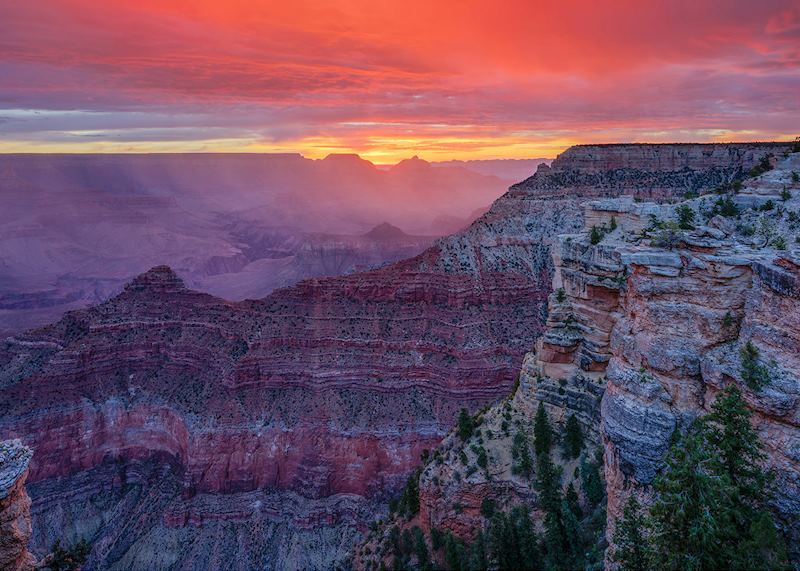
Watching the sunrise. Not as many people make the effort to watch the sunrise compared with sunset, so you can really take everything in.
I woke up to clear skies, and made my way to Mather Point on the South Rim. While this is one of the most popular places to see the sunrise, you can walk a bit farther along to find a space of your own. When I got there, the canyon was cloaked in a charcoal-gray darkness. But, as I watched, the sun crept up onto the horizon and pale light gradually slipped over the canyon. It was like a curtain had been opened, revealing the textures and rust-red strata of the rock in a warm glow.
Read more about trips to the USA
Start thinking about your experience. These itineraries are simply suggestions for how you could enjoy some of the same experiences as our specialists. They're just for inspiration, because your trip will be created around your particular tastes.
View All Tours in The US